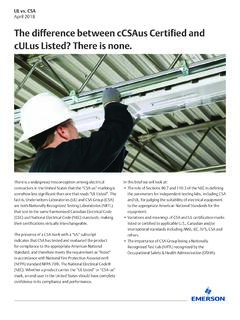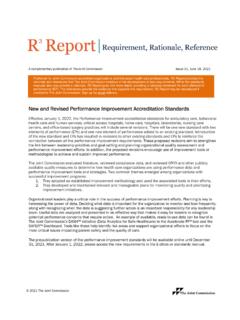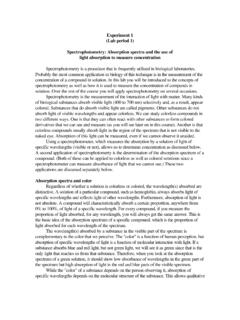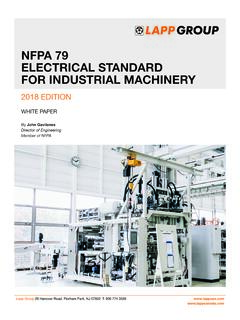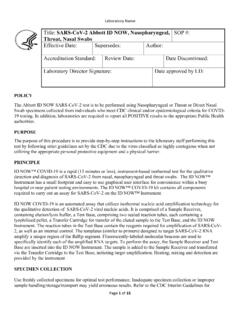Transcription of System Specification, Design and Installation
1 white PAPERThe #1 Value in Automation. A Condensed Guide to Automation control System Specification, Design & Installation : white paper , Title Page A Condensed Guide to Automation control System Specification, Design and InstallationBy Tom ElavskyAutomationDirectWHITE PAPERThe #1 Value in Automation. Save up to 50% on Industrial Controls: following is Part 1 of a four-part series of articles on control System Design that can act as a general guide to the specification, Design and Installation of automated control systems. The information and references are presented in a logical order that will take you from the skills required to recognize an operation or process suited for automating, to tips on setting up a program, to maintaining the control System . Whether you are an expert or a novice at electrical control devices and systems, the information presented should give you a check list to use in the steps to implementing an automated control System .
2 Electrical control systems are used on everything from simple pump controls to car washes, to complex chemical processing plants. Automation of machine tools, material handling/conveyor systems, mixing processes, assembly machines, metal processing, textile processing and more has increased productivity and reliability in all areas of manufacturing, utilities and material may have come to realize that an operation or process used to produce your end product is very laborious, time consuming, and produces inconsistent results. You may have also visualized ways that would allow you to automate the operation. Automating the process will reduce the amount of manual labor, improve throughput and produce consistent results. You may have the skills to develop the mechanical means and select the appropriate equipment to make this happen, and although you have a basic understanding of electrical control devices, you may not have the experience to put it all together.
3 Your first option may be to enlist the help of a qualified System Integrator. If you do decide to use a System Integrator, it would be beneficial to understand as much as possible about automation control System devices and their terminology so that your communications with the System Integrator go faster and more smoothly. In most cases, special expertise is required to Design and install industrial automation control systems. Persons without such expertise or guidance should not Design and install automation control systems because they can fail and cause serious injury to personnel or damage to equipment. The information provided in this whitepaper is provided as is without a guarantee of any kind. We do not guarantee that the information is suitable for your particular application, nor do we assume any responsibility for its use in your is our intent to produce this whitepaper as a usable guide, with additional information, including a typical real world application that can be followed from concept to completion.
4 It is not our intent for the guide to cover every possible topic dealing with automation control systems or to even suggest that the topics being covered are fully detailed. Instead, the topics are aimed at giving the reader a good starting reference for automated control systems. In Part 1, we will cover the topics of Safety and Identifying an operation or process that could benefit from automation. We will then cover control device specification, control System Design and construction, control System Installation , and finally control System A Condensed Guide to Automation control System Specification, Design & Installation : white paper , pg. 2 white PAPERThe #1 Value in Automation. Save up to 50% on Industrial Controls: The topics will be broken down as follows: Part 1 - SAFETY and IDENTIFICATION Part 2 - SPECIFICATION Part 3 - Design and BUILD Part 4 - INSTALL and MAINTAINPart 1: System Identification and SafetyThe first and most important item to consider before attempting an automated control System , or even a simple on/off control for a pump, is safety, both for personnel who may be working with or near the automated equipment, as well as to prevent damage to the minimize the risk of potential safety problems, you should follow all applicable local, state and national codes that regulate the Installation and operation of your con- trol System , along with the equipment or process it is designed to control .
5 These codes vary by area and usually change over time. It will be your responsibility to determine which codes should be followed and to verify that the equipment, Installation , and operation is in compliance with the latest revision of these likely your control System will be dealing with electrical energy, so your first goal will be to eliminate the risk of fire and electrical shock to personnel. The top organizations that provide applicable standards and codes are referenced below, but even before you get to this area of safety, it would be wise to educate yourself as much as possible about electricity and electrical equipment in general. A good understanding of basic electricity, including DC and AC theory and practice, Ohm s Law, etc. will go a long way in helping you understand the various codes and standards . There are many good publications and articles on the subject of basic electricity and some local technical colleges offer courses covering subjects dealing with basic electricity.
6 Some even offer courses in Programmable Logic Controllers (PLCs), which can be very useful when dealing with automated control systems. Also, many Web sites offer free tutorials covering basic electricity and PLCs. It would be beneficial to have some understanding of electronic devices, such as the operation of a transistor and other solid state devices, as well as understanding of the use and operation of electrical test and measurement instruments, such as voltmeters, current loop meters, clamp-on amp meters, etc. At a minimum, you should follow all applicable sections of the National Fire Protection Association (NFPA) fire code, and the codes of the National Electrical Manufacturer s Association (NEMA). There may also be local regulatory or government offices that can help determine which codes and standards are necessary for the safe Installation and operation of electrical control equipment and Condensed Guide to Automation control System Specification, Design & Installation : : white paper , pg.
7 3 white PAPERThe #1 Value in Automation. Save up to 50% on Industrial Controls: area of safety that needs to be considered for automated control systems is lockout/tagout procedures as specified by Occupational Safety and Health Administration (OSHA). Lockout/tagout refers to specific practices and procedures to safeguard operators and maintenance personnel from the unexpected energization or startup of machinery and equipment, or the release of hazardous energy during service or maintenance activities. In order to have your control System make use of a lockout/tagout procedure, the Design should include the ability to shut off, neutralize, or isolate any energy source, such as the main electrical feed, but also any pneumatic, hydraulic or mechanical energy storage device. The means to do this should be considered in the initial Design of the automated control System . Additional information can be found on OSHA s Web site at: are many reasons why the electrical devices that you will use in the Design of your automated control System should be listed, approved or registered with a testing laboratory.
8 One reason is to ensure that the device meets standards that will prevent failure that could lead to catastrophic results. Another reason might be for insurance or compliance purposes. One of the most specified and premier safety testing laboratories is Underwriters laboratories (UL). One of the most applicable areas of interest for con- trol systems is UL s Standard for Safety 508A. If your control System panel requires being built to UL508A, then you will need to contract directly with UL to become a UL508A panel builder or use an existing UL508A panel builder. Additional information can be found at: to UL508A for AutomationDirect products can be found on our Web site at: following are other safety points to consider in the Design of your automated control System : - Emergency Stop - The control System must provide a quick manual method of disconnecting all System power to the machinery, equipment or process.
9 The discon-nect device or switch must be clearly labeled Emergency Stop . After an Emergency shutdown or any other type of power interruption, there may be requirements thatmust be met before the control System or PLC control program can be restarted. For example, there may be specific register values in the PLC memory that must be established (or maintained from the state prior to the shutdown) before operations can resume. There may also be mechanical positions of equipment that have to be moved or jogged to the proper position. - Accidental Powering of Outputs - Do not rely on the automation control System alone to provide a safe operating environment. You should use external electro-mechanical devices, such as relays or limit switches, that are independent of any elec-tronic controlling devices, such as a solid state relay or a PLC output module, to provide protection for any part of the System that may cause personal injury or damage.
10 These devices should be installed in a manner that prevents any machine operations from occurring unexpectedly. For example, if the machine has a jammed part, the controlling System or PLC program can turn off the motor rotating a saw blade. However, since A Condensed Guide to Automation control System Specification, Design & Installation : : white paper , pg. 4 white PAPERThe #1 Value in Automation. Save up to 50% on Industrial Controls: operator must open a guard to remove the part, you should also include a bypass switch that disconnects all System power any time the guard is opened. - Orderly Equipment Shutdown - Whether using a control System designed around relays and timers or a PLC, an orderly System shutdown sequence should be included in your Design . If a fault is detected, then any mechanical motion, valve position, etc., needs to be returned to its fail-safe position and the equipment/process stopped.


